Every year, billions of birds migrate (sometimes for thousands of miles), to their breeding grounds and back again. Many of them follow well established routes known as ‘flyways.’ I know birders who travel each year to watch the migration of raptors, including bald eagles. The internet provides fascinating information if you are interested to learn more about these extraordinary journeys. To give just a few examples from my browsing:
The Arctic tern, Sterna paradisaea has the longest recorded migration of any bird on the planet – a round trip of roughly 22,000 miles, some 11,000 miles each way – from its breeding grounds in the Arctic and back to the Antarctic.
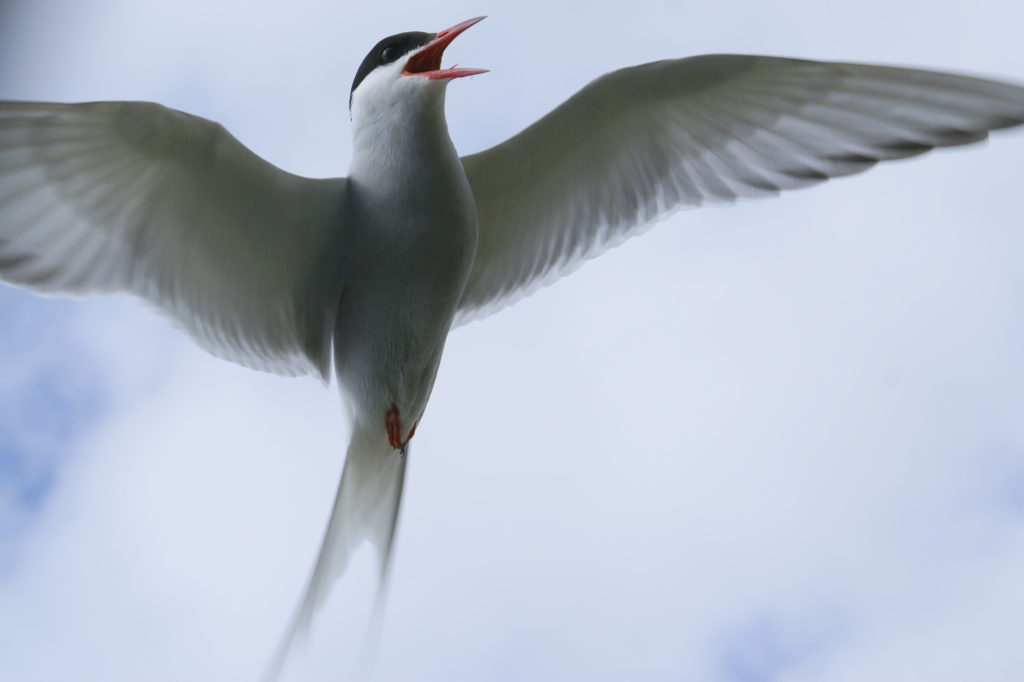
The little shorebird, a female godwit, was recently found to have flown 7,145 miles (11,500 kilometers) nonstop from Alaska to New Zealand—without taking a break for food or drink. It’s the longest nonstop bird migration ever measured, according to biologists from the U.S. Geological Survey and the NGO PRBO Conservation Science.
Then there is the even smaller shorebird, the red knot, that travels to and from the very southernmost tip of South America all the way to the Arctic Circle! Hummingbirds – I was so surprised when I first heard about humming bird migrations – the Rufous Hummingbird, just over 3 inches long, migrates roughly 3,900 miles from Mexico to Alaska. And then, after breeding, flies all the way back!
Dangers faced by migrating birds
There are many dangers along the way for these feathered travelers. Some are natural hazards, such as storms that blow the birds far out of their path. But most, today, are the result of human activity. In some countries, such as Italy, France, and Malta, hunters eagerly await the arrival of migrating birds. I got involved with the program to rescue the northern bald ibis from extinction which involved training captive bred birds to follow an ultra light from Austria to Italy. The first bird to make the journey on her own was named for me – Goja (first two letters of Goodall, Jane!). On her way back to Austria she, and one of her two young, were shot and killed by an Italian hunter (This started a major campaign to inform and educate people along the migration route).

via Audubon Photo: Thierry Cohen/Danziger Gallery
A very serious danger, for species that fly at night, are the lights of the high rise buildings in our cities. The Fatal Light Awareness Program (Flap) (a project in Toronto, Canada) estimates that “Across North America, more birds die from collisions each year than succumbed to the Exxon Valdez oil spill” – a disaster which killed more than 250,000 birds.
Fortunately this danger is being addressed. The National Audubon Society has initiated a ‘Lights Out” program during the main migration season. Tall buildings are asked to dim their lights (or turn them off when possible) between midnight and dawn. Late workers are urged to pull down blinds or use desk lights. New York officially joined this initiative, and other cities, including Baltimore, Washington, Minneapolis, San Francisco and Chicago, are also joining.
Lingang Bird Airport in China
One of the major routes that is used by birds migrating from the Arctic Circle is through east and south-east Asia to the southernmost areas of Australia and New Zealand. This is the Arctic Asian/Australasian Flyway used by some 50 million birds species, including many water birds. During the marathon flights along this flyway there are, for most species, areas where they pause to rest and fatten up in order to continue to their final destination. Many of the species that use this flyway are becoming increasingly endangered as development and draining of wetlands along the shores of China’s Yellow Sea degrades or destroys these essential stopovers.
But help is at hand! I just heard, from friends in China about an extraordinary project designed to help millions of birds during their migration – the world’s first “Bird Airport.” By the end of this year, work will have started on the building of a wetland sanctuary in Tianjin. The designated area is, at present, a landfill site, and it lies directly in the path of the Arctic Asian/Australasian Flyway. When the idea was launched, a number of architects tendered bids: the winning design was that of McGregor Coxall.

Rendering: McGregor Coxall
The whole project, which will be completed by the end of 2018, will cover some 60 hectares and provide suitable habitats for more than 50 species of bird many of which are endangered. The finished ‘airport’ will be comprised of wetlands, a lake with shallow rapids, a reed zone and mudflats. There will also be parkland and the whole area will be fringed by a strip of urban forest to protect the birds from intrusion from nearby urban development. Recycled waste water and harvested rain water will be used to irrigate the wetlands and the whole project will be powered by renewable energy.
Adrian McGregor, CEO and lead designer of McGregor Coxall, explains the inspiration behind the project: “The Earth’s bird flyways are a wonder of the natural world. The proposed Bird Airport will be a globally significant sanctuary for endangered migratory bird species whilst providing new green lungs for the city of Tianjin.”
There will be trails for visitors and a world-class education and research center. I am hoping that this can become a mecca for Roots & Shoots groups in China to learn about the astonishing migrations of birds!
The migration of the Sandhill cranes.
Every spring for the past 15 years, I have spent some days in late March or early April in Nebraska during the migration of Sandhill cranes and snow geese. I stay with Tom Mangelsen (Read more about Tom here) and a few close friends at his cabin nestled on the bank of the Platte River. It is surrounded by fields that lie bare after the harvest and is a stopover where the birds interrupt their long flight to their breeding grounds in Alaska, Canada or Siberia to feed on corn left over from the harvest, building up fat reserves for the long journey ahead. Sandhill cranes are only one of a number of birds who use this stopover along the Platte, including snow geese and others – a total of some 20 million birds.
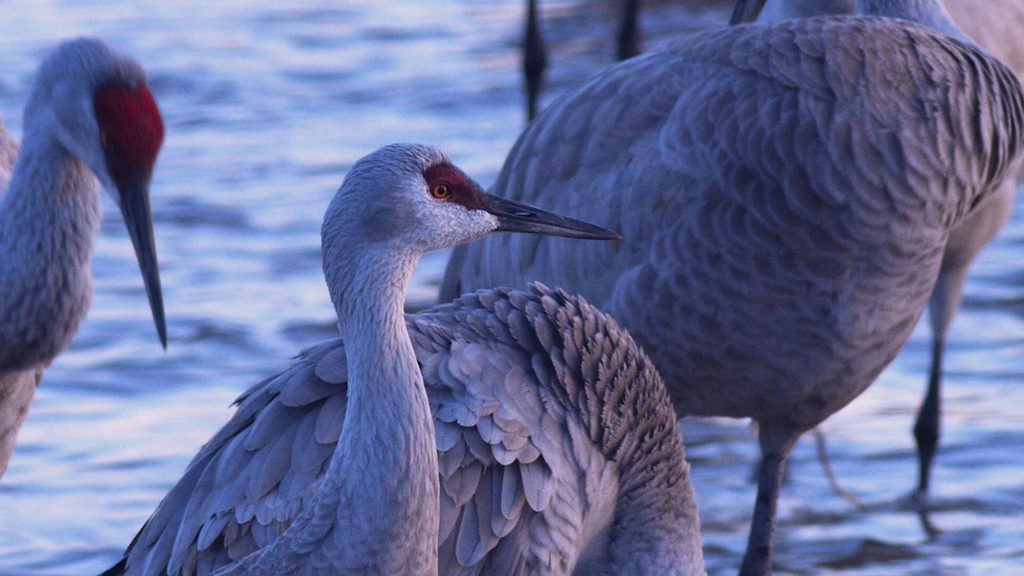 Those are magical days, waking to the sound of the cranes flying past my picture frame window to the cornfields for the day’s foraging. I can never properly describe the sound of their creaking voices, but they speak of far away places and of the world as it was, for they are an ancient species. Sometimes driving along the gravel roads between the fields in the afternoon, pausing to watch them feed and, every so often leaping up with outstretched wings, dancing. Best of all is watching them fly in to their roosts on the river each evening. It is always cold (though not as consistently cold now as it was 15 years ago), and there is nothing like when the last cranes have flown in and it is quite dark, walking back to the cabin to blow the log fire back to life, raising a glass and wishing the cranes luck on their long journey.
Those are magical days, waking to the sound of the cranes flying past my picture frame window to the cornfields for the day’s foraging. I can never properly describe the sound of their creaking voices, but they speak of far away places and of the world as it was, for they are an ancient species. Sometimes driving along the gravel roads between the fields in the afternoon, pausing to watch them feed and, every so often leaping up with outstretched wings, dancing. Best of all is watching them fly in to their roosts on the river each evening. It is always cold (though not as consistently cold now as it was 15 years ago), and there is nothing like when the last cranes have flown in and it is quite dark, walking back to the cabin to blow the log fire back to life, raising a glass and wishing the cranes luck on their long journey.
Most years I manage to write about these wonderful days, trying to capture something of the magic so that I can read of it in old age. So, for this International Migratory Bird Day, I thought I would share some of these musings. Here they are, just as they were written, a pot pourie of memories:
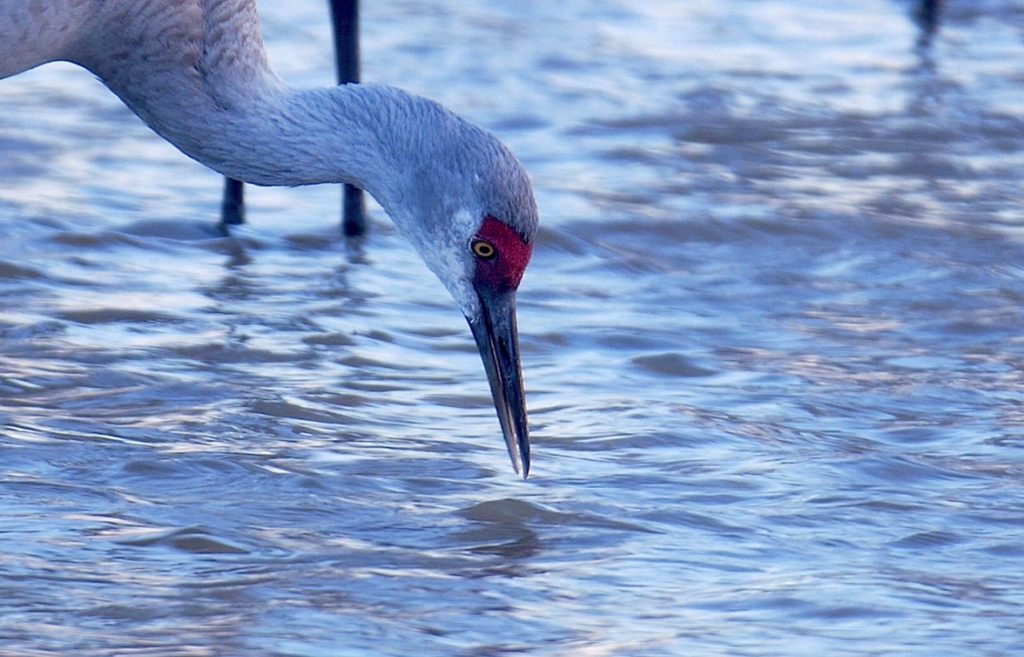 Day 1 It is a glorious evening and the cranes came in for over an hour. The sunset was soft, golden and a much less vivid red than last night. There was no wind at all, and it was absolute magic sitting and looking along the Platte, stretching in silvered braids to the south. At first the cranes came in small family groups, but gradually the size of the flocks increased. They flew in towards us, many passing and settling further downstream, others came down almost in front of the cabin, circling then seeming to float down, long leg dangling. As more arrive, it is harder for them to find a place, and gradually all the sand bars are covered by a grey feather carpet. Between them and us is a tight-knit group of 12 pelicans, preening.
Day 1 It is a glorious evening and the cranes came in for over an hour. The sunset was soft, golden and a much less vivid red than last night. There was no wind at all, and it was absolute magic sitting and looking along the Platte, stretching in silvered braids to the south. At first the cranes came in small family groups, but gradually the size of the flocks increased. They flew in towards us, many passing and settling further downstream, others came down almost in front of the cabin, circling then seeming to float down, long leg dangling. As more arrive, it is harder for them to find a place, and gradually all the sand bars are covered by a grey feather carpet. Between them and us is a tight-knit group of 12 pelicans, preening.
Day 2 A very low key, soft sky, golden and orange red, and thousands and thousands of cranes. It almost seemed there were more than any of the previous evenings. There was no cold wind, nothing to detract from the sheer magic of those winged beings that appeared in the distance as grey wisps of mist that gradually resolved into V shaped lines against the sky, then finally into individual birds as they flew overhead. They landed right along the river, closer than before. Until all the river was mantled with soft grey brown feathers. A bald eagle flew by startling some of them into flight, but they merely circled round and soon landed again.
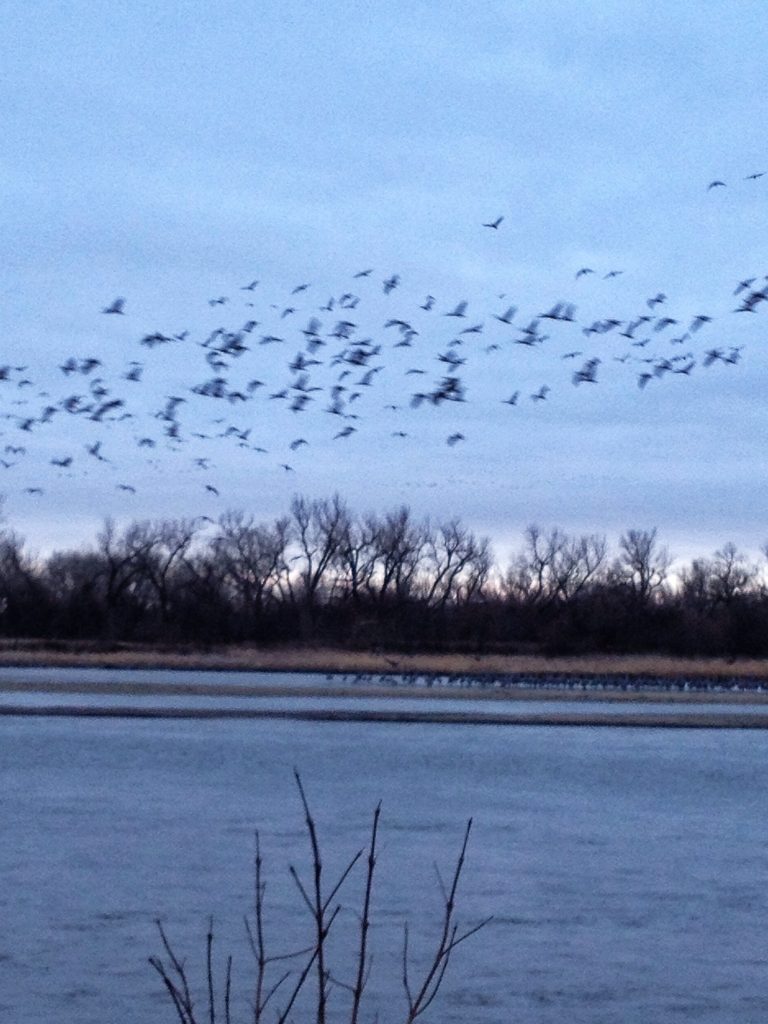 Day 3 From 6:30 AM to 7:30 AM the next morning the cranes leave in orderly groups. They fly, low and determinedly, up river to the south, past my picture frame window where dozens of goldfinches are hungrily eating the seed that Tom puts out lavishly, every day. There is a black squirrel, handsome and sleek among his grey brown brothers and sisters. They are all fat. There are flickers and woodpeckers and the redwing blackbirds are arriving,
Day 3 From 6:30 AM to 7:30 AM the next morning the cranes leave in orderly groups. They fly, low and determinedly, up river to the south, past my picture frame window where dozens of goldfinches are hungrily eating the seed that Tom puts out lavishly, every day. There is a black squirrel, handsome and sleek among his grey brown brothers and sisters. They are all fat. There are flickers and woodpeckers and the redwing blackbirds are arriving,
Day 4 Still the cranes fly past, all seeming to head in the same direction. Not very talkative this morning. Close to the window, a doe and yearling walk past, slowly, daintily, and vanish into tall grass. Presently, another doe and her young one. Then two wood ducks arrive on the pond and swim around purposefully, as though checking out the territory. Another doe and yearling. And still the cranes are flying up river, huge wings flap, flap flapping, heading for the corn fields. Then three turkeys walk past, one tom and his wives. A few more cranes – some flying in the opposite direction – lonely and uttering their sad calls, searching for a missing mate or parent. Finally all is quiet. The show is over for another morning.
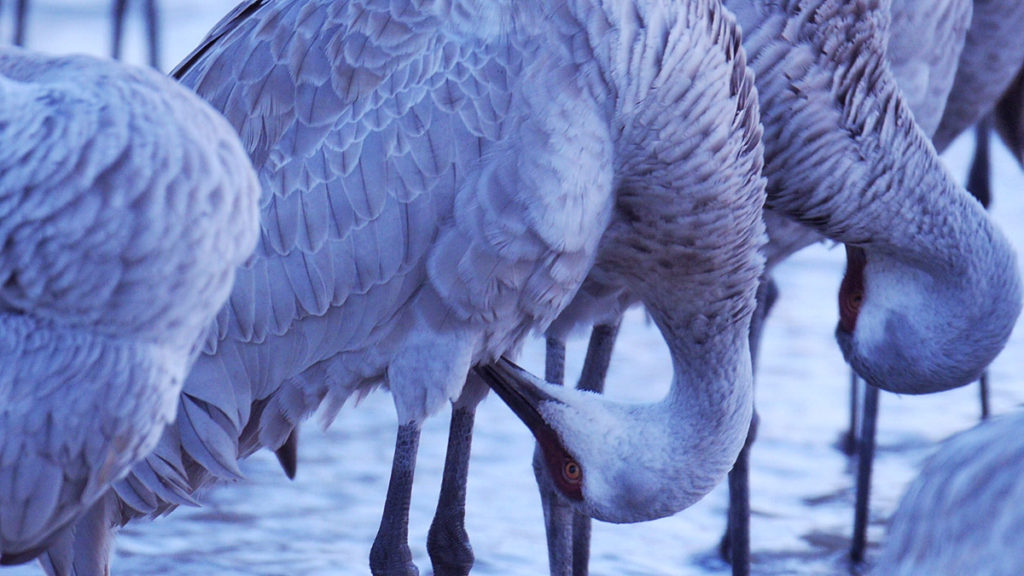 Day 4 We spent a couple of hours in the afternoon, Tom and I, hoping to see a whooping crane. We drove past endless straw colored fields of stubble, drained wetlands, and crouching, menacing center pivots. We saw lots of Sandhill cranes searching for corn. Surely, I thought, all the fields have been picked through, again and again? So many hungry birds. How could there possibly be any grain left? And who decided which direction to fly that morning, and which fields to search? Crane mysteries.
Day 4 We spent a couple of hours in the afternoon, Tom and I, hoping to see a whooping crane. We drove past endless straw colored fields of stubble, drained wetlands, and crouching, menacing center pivots. We saw lots of Sandhill cranes searching for corn. Surely, I thought, all the fields have been picked through, again and again? So many hungry birds. How could there possibly be any grain left? And who decided which direction to fly that morning, and which fields to search? Crane mysteries.
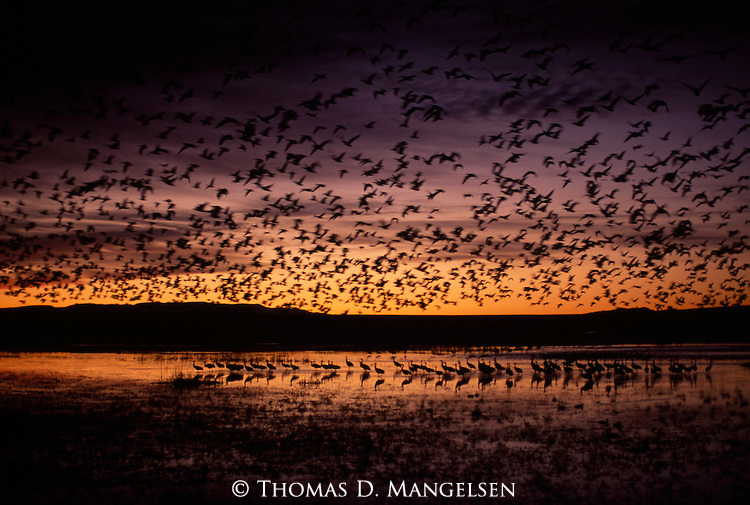
Flashback: Last year there was one extraordinary evening – I think was the best EVER – which is saying something! Come with me in my memory as I walk with Tom, Dan Miller and Susana from the cabin along the trail to our favorite viewing place. We arrive and sit where we can look along the river towards the sunset. There are very dark clouds overhead and the faint rumbling of thunder. On the horizon is a small clear opening between land and cloud, the only place where light from the setting sun lit up the water. And as the sun got lower, the yellow turned to gold, and then to an amazing red. It was as though there was a fire illuminating the land and the river. Against this sky the cranes came flying in, mostly in groups of around 15, some family groups – three or four. More and more cranes flew across the sunset – thousands of them, their wings silvery white against the black-blue sky. Soon the noise of their calling is all around us. Meanwhile, the thunder is getting nearer and nearer and then the lightning begins – brilliant sheet lighting and forked lightning on both sides of us. Some of the thunder claps are right overhead. The cranes seem upset – flying up from the roost and passing us upstream, circling and returning. We are all in awe. And then, heralded by a huge clap of thunder, it begins to rain. Huge cold drops falling faster and faster. Not just a little shower, this is torrential rain. We return to a log fire, a glass of wine, a simple dinner. Each with a memory that will last for ever.




